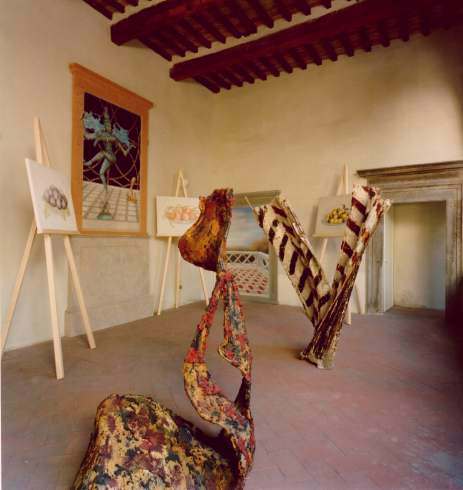
Dana for Nataraja
A votive installation at Palazzo Ducci del Rosso Sansepolcro, Italy
Dana
for Nataraja is a pictorial installation that can be
located in that wide fluxus of thought that is at the origin of Ritual
Art in its aspect of devotional or votive paintings.
The structure of the votive cycle has always been formed by three
elements, Donor, Donee, and the offerings through which the ritual
act is performed.
Functions
defining the net of the votive act may change in time in the same
way that meanings may be modified and relationships established but
the essence is a unique, simple mechanism, based on the magical protective
or propitiatory power of the principle of resemblance, proximity,
or contact.
In
this ambit it happens that the Donor often has himself portrayed along
with the divinity to which the work is dedicated. For example, in
the spring of 1451, Piero della Francesca was commissioned to paint,
in the Malatestian temple at Rimini, the scene commemorating the consecration
of this imposing dynastic and religious monument. In his fresco Piero
represented his donor, Sigismondo Malatesta, in the act of receiving
a dynastic investiture from his omonymus saint. Bearing in mind that the essence of votive art is always of a magical
nature, that means based on associations of a « sympathetic » nature,
it is not so difficult to understand the circumstance in which the
Donor has himself portrayed in the clothes of the donee as in the
piece that Matthias Grunewald painted for the Archbishop of the town
of Halle, Albrecht von Brandenburg, where he is portrayed in Saint
Erasmus's clothes. Archbishop von Brandenburg not only professed himself
to be a faithful Erasmian, but also probably hoped to acquire, by
the magical use of this symbol, some of the real Erasmian values.
It
is hard to imagine finding a Donor wishing to do this nowadays, but
indeed the fascination of the ritual act still continues, and in the
autonomous and pathless territory of art, there is still the possibility
of evoking it.